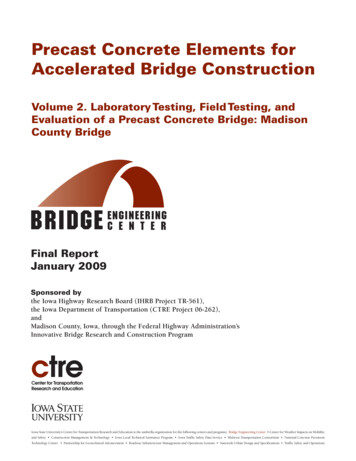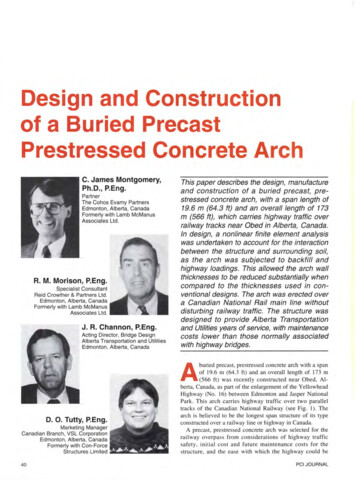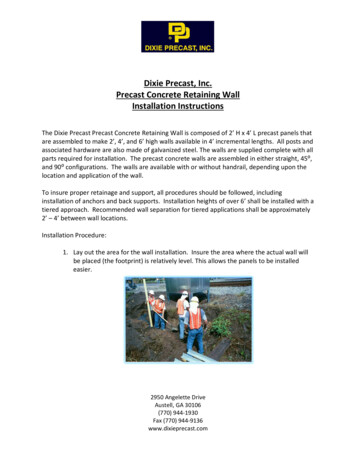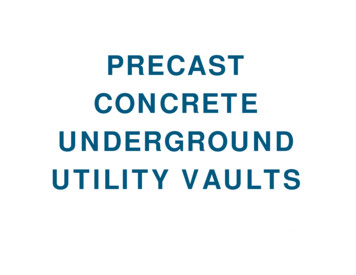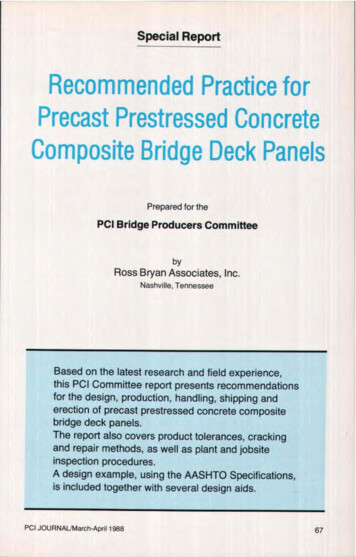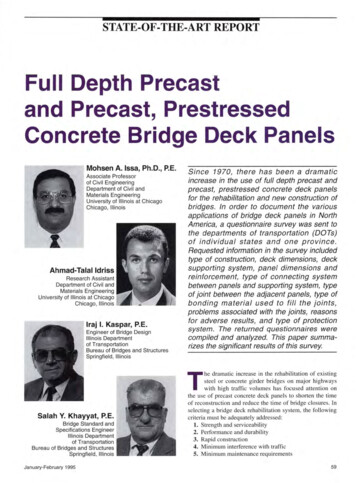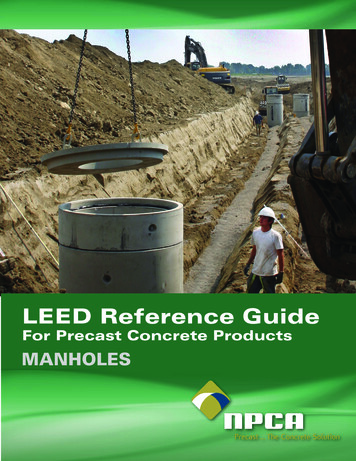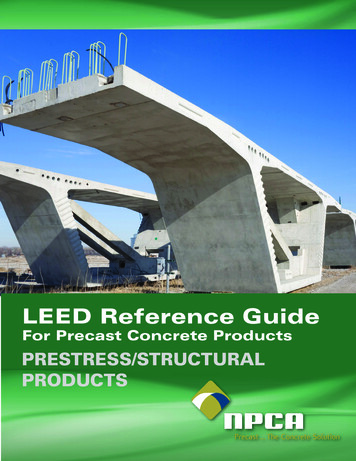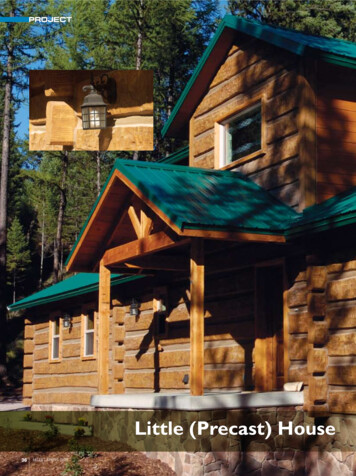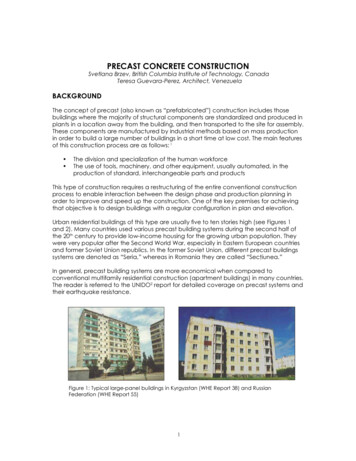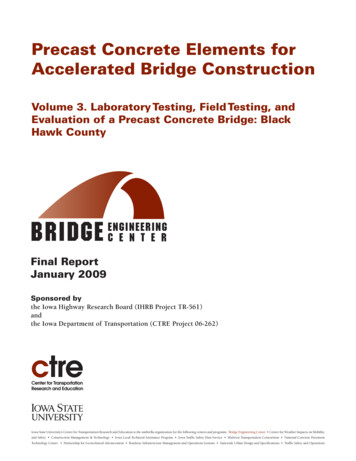
Transcription
Precast Concrete Elements forAccelerated Bridge ConstructionVolume 3. Laboratory Testing, Field Testing, andEvaluation of a Precast Concrete Bridge: BlackHawk CountyFinal ReportJanuary 2009Sponsored bythe Iowa Highway Research Board (IHRB Project TR-561)andthe Iowa Department of Transportation (CTRE Project 06-262)Iowa State University’s Center for Transportation Research and Education is the umbrella organization for the following centers and programs: Bridge Engineering Center Center for Weather Impacts on Mobilityand Safety Construction Management & Technology Iowa Local Technical Assistance Program Iowa Traffic Safety Data Service Midwest Transportation Consortium National Concrete PavementTechnology Center Partnership for Geotechnical Advancement Roadway Infrastructure Management and Operations Systems Statewide Urban Design and Specifications Traffic Safety and Operations
About the Bridge Engineering CenterThe mission of the Bridge Engineering Center is to conduct research on bridge technologies tohelp bridge designers/owners design, build, and maintain long-lasting bridges.Disclaimer NoticeThe contents of this report reflect the views of the authors, who are responsible for the factsand the accuracy of the information presented herein. The opinions, findings and conclusionsexpressed in this publication are those of the authors and not necessarily those of the sponsors.The sponsors assume no liability for the contents or use of the information contained in thisdocument. This report does not constitute a standard, specification, or regulation.The sponsors do not endorse products or manufacturers. Trademarks or manufacturers’ namesappear in this report only because they are considered essential to the objective of the document.Nondiscrimination StatementIowa State University does not discriminate on the basis of race, color, age, religion, nationalorigin, sexual orientation, gender identity, sex, marital status, disability, or status as a U.S.veteran. Inquiries can be directed to the Director of Equal Opportunity and Diversity,(515) 294-7612.
GENERAL ABSTRACTPrecast Concrete Elements for Accelerated Bridge ConstructionPrecast concrete elements and accelerated bridge construction techniques have the potential toimprove the health of the U.S. highway system. In precast bridge construction, the individualcomponents are manufactured off-site and assembled on-site. This method usually increases thecomponents’ durability, reduces on-site work and construction time, minimizes traffic disruption,and lowers life-cycle costs. Before widespread implementation, however, the benefits of precastelements and accelerated bridge construction must be verified in the laboratory and field.For this project, precast bridge elements and accelerated bridge construction techniques wereinvestigated in the laboratory and at three bridge projects in Iowa: in Boone County, MadisonCounty, and Black Hawk County. The objectives were to evaluate the precast bridge elements,monitor the long-term performance of the completed bridges, and evaluate accelerated bridgeconstruction techniques.The results of these investigations are presented in three volumes, as described below; thisvolume is Volume 3.Vol. 1-1. Laboratory Testing of Precast Substructure Components: Boone County Bridge1-2. Laboratory Testing of Full-Depth Precast, Prestressed Concrete Deck Panels:Boone County Bridge1-3. Field Testing of a Precast Concrete Bridge: Boone County BridgeIn 2006, a continuous four-girder, three-span bridge was constructed that included precastabutments, pier cap elements, prestressed beams, and precast full-depth deck panels. All ofthe precast elements performed well during strength testing and were set quickly andsmoothly during construction, and the completed bridge experienced very smalldisplacements and strains when subjected to live loads.Vol. 2. Laboratory Testing, Field Testing, and Evaluation of a Precast Concrete Bridge:Madison County BridgeIn 2007, a two-lane single-span bridge was constructed that had precast box girders withprecast abutments. The elements performed well during laboratory load transfer andstrength testing, and the completed bridge performed well in terms of maximum deflectionsand differential displacements between longitudinal girder joints.Vol. 3. Laboratory Testing, Field Testing, and Evaluation of a Precast Concrete Bridge:Black Hawk CountyIn 2007, two precast modified beam-in-slab bridge (PMBISB) systems were constructed,each of which included precast abutment caps, backwalls, and deck panels. Various deckpanel configurations transferred load effectively during laboratory testing, and all precastelements met expectations. The completed bridges experienced very low induced stressesand met AASHTO deflection criteria, while the PMBSIB system effectively transferredload transversely.
Technical Report Documentation Page1. Report No.IHRB Project TR-5612. Government Accession No.3. Recipient’s Catalog No.4. Title and SubtitlePrecast Concrete Elements for Accelerated Bridge Construction: LaboratoryTesting, Field Testing, and Evaluation of a Precast Concrete Bridge, Black HawkCounty5. Report DateJanuary 20097. Author(s)Wayne Klaiber, Terry Wipf, Vernon Wineland8. Performing Organization Report No.CTRE Project 06-2629. Performing Organization Name and AddressBridge Engineering CenterIowa State University2711 South Loop Drive, Suite 4700Ames, IA 50010-866410. Work Unit No. (TRAIS)12. Sponsoring Organization Name and AddressIowa Highway Research BoardIowa Department of Transportation800 Lincoln WayAmes, IA 500106. Performing Organization Code11. Contract or Grant No.13. Type of Report and Period CoveredFinal Report14. Sponsoring Agency Code15. Supplementary NotesVisit www.ctre.iastate.edu for color PDF files of this and other research reports.16. AbstractThe importance of rapid construction technologies has been recognized by the Federal Highway Administration (FHWA) and the IowaDOT Office of Bridges and Structures. Black Hawk County (BHC) has developed a precast modified beam-in-slab bridge (PMBISB)system for use with accelerated construction. A typical PMBISB is comprised of five to six precast MBISB panels and is used on lowvolume roads, on short spans, and is installed and fabricated by county forces. Precast abutment caps and a precast abutment backwallwere also developed by BHC for use with the PMBISB. The objective of the research was to gain knowledge of the global behavior ofthe bridge system in the field, to quantify the strength and behavior of the individual precast components, and to develop a more timeefficient panel-to-panel field connection. Precast components tested in the laboratory include two precast abutment caps, three differenttypes of deck panel connections, and a precast abutment backwall. The abutment caps and backwall were tested for behavior andstrength. The three panel-to-panel connections were tested in the lab for strength and were evaluated based on cost and constructability.Two PMBISB were tested in the field to determine stresses, lateral distribution characteristics, and overall global behavior.17. Key Wordsaccelerated bridge construction—Black Hawk County, Iowa—field testing—labstrength testing—precast abutment caps, backwalls, and deck panels18. Distribution StatementNo restrictions.19. Security Classification (of thisreport)Unclassified.21. No. of Pages22. Price97NA20. Security Classification (of thispage)Unclassified.
PRECAST CONCRETE ELEMENTS FORACCELERATED BRIDGE CONSTRUCTION:LABORATORY TESTING, FIELD TESTING, AND EVALUATIONOF A PRECAST CONCRETE BRIDGE, BLACK HAWK COUNTYFinal ReportJanuary 2009Principal InvestigatorTerry J. Wipf, Director, Bridge Engineering CenterCenter for Transportation Research and Education, Iowa State UniversityCo-Principal InvestigatorsWayne Klaiber, Professor, Department of Civil, Construction, and Environmental EngineeringCenter for Transportation Research and Education, Iowa State UniversityBrent Phares, Associate Director, Bridge Engineering CenterCenter for Transportation Research and Education, Iowa State UniversityResearch AssistantVernon WinelandAuthorsWayne Klaiber, Terry Wipf, Vernon WinelandSponsored bythe Iowa Highway Research Board (IHRB Project TR-561)Preparation of this report was financed in partthrough funds provided by the Iowa Department of Transportationthrough its research management agreement with theCenter for Transportation Research and Education (CTRE Project 06-262).Center for Transportation Research and EducationIowa State University2711 South Loop Drive, Suite 4700Ames, IA 50010-8664Phone: 515-294-8103Fax: 515-294-0467www.ctre.iastate.edu
TABLE OF CONTENTSACKNOWLEDGMENTS . XIEXECUTIVE SUMMARY . XIII1. INTRODUCTION .11.1 Background .11.2 Research Objectives .21.3 Scope of Research .21.4 Literature Review.32. LABORATORY TESTING.82.1 Abutment Caps.82.1 Precast Panel Connections .152.2 Abutment Backwall .313. LABORATORY TESTING RESULTS .383.1 Abutment Cap Test Results .383.2 Connection Test Results .473.3 Abutment Backwall Test Results .514. BRIDGE CONSTRUCTION AND FIELD TESTING .554.1 Mt. Vernon Road Bridge.554.2 Marquis Road Bridge .615. BRIDGE FIELD TESTING RESULTS .655.2 Mt. Vernon Road Bridge.655.2 Marquis Road Bridge .746. SUMMARY AND CONCLUSIONS .796.1 Summary .796.2 Conclusions .80REFERENCES .82v
LIST OF FIGURESFigure 1.1. BISB cross section.5Figure 1.2. MBISB variation 1 cross section .7Figure 1.3. MBISB variation 2 cross section .7Figure 1.4. PMBISB cross section .7Figure 2.1. Precast abutment caps.8Figure 2.2. Strain gages on 14 in. pile section .10Figure 2.3. Cap 1 instrumentation plan .11Figure 2.4. Cap 1 service test set-up .11Figure 2.5. Positive ultimate strength bending test set-up .12Figure 2.6. Negative ultimate strength bending test set-up .13Figure 2.7. Cap 2 instrumentation plan .14Figure 2.8. Cap 2 service test set-up .14Figure 2.9. Positive ultimate strength bending test set-up .15Figure 2.10. Original PMBISB field connection .16Figure 2.11. Revised system .16Figure 2.12. Type 1 Connection .17Figure 2.13. Type 1 Connection form details .18Figure 2.14. Photograph of reinforcement in forms .19Figure 2.15. Finished concrete surface of Type 1 Connection .20Figure 2.16. Position of reinforcing bar before closure .20Figure 2.17. Type 2 Connection .21Figure 2.18. Type 2 Connection form details .22Figure 2.19. Type 2 Connection reinforcing detail .22Figure 2.20. Finished concrete and positioned anchors for Type 2 Connection.23Figure 2.21. Type 2 Connection prepared for closure pour .24Figure 2.22. Type 3 Connection .25Figure 2.23. Completed formwork for Type 3 Connection .26Figure 2.24. Finished concrete for Type 3 Connection .26Figure 2.25. Formwork for closure in Type 3 Connection .27Figure 2.26. Typical service load test .27Figure 2.27. Typical ultimate load test .28Figure 2.28. Strain gage locations in all three connections .29Figure 2.29. Additional strain gages positioned on bottom plate in Type 2 Connections .29Figure 2.30. Size of load area on connection surface .30Figure 2.31. Ultimate load test set-up .31Figure 2.32. Abutment backwall reinforcement details .32Figure 2.33. Abutment backwalls in the field .32Figure 2.34. Correlation of field conditions to the laboratory set-up .33Figure 2.35. Strain gage instrumentation for backwall service test .34Figure 2.36. Location of deflection transducers for abutment backwall service load test.35Figure 2.37. Backwall supported by 2-HP 10x42s .35Figure 2.38. Position of loads used in backwall service load tests .36Figure 2.39. Additional instrumentation used in the ultimate strength test of the abutmentbackwall .36vii
Figure 2.40. Strength test of the precast abutment backwall .37Figure 3.1. Identification of strain gages used on Cap 1 .38Figure 3.2. Identification or strain gages used on Cap 2 .38Figure 3.3. Support conditions for Cap 1 for each load point.39Figure 3.4. Support conditions for Cap 2 for each load point.40Figure 3.5. Deflection profile for Cap 1 for the seven load points used .40Figure 3.6. Deflection profile for Cap 2 for the six load points used .41Figure 3.7. Steel strains for Cap 1 for the seven load points used .42Figure 3.8. Steel strains for Cap 2 for the six load points used .42Figure 3.9. Cap 1 neutral axis at Section 2, Load Position 1, 40 kip load .43Figure 3.10. Cap 1 neutral axis at Section 2 plotted against load .44Figure 3.11. Cap 2 neutral axis at Section 1, Load Positions 1 and 2, at 40 kips .45Figure 3.12. Plot of load vs. deflection for positive capacity tests of caps .46Figure 3.13. Plot of load vs. deflection for negative capacity test of Cap 1 .47Figure 3.14. Type 1 Connection service deflections.48Figure 3.15. Type 2 Connection service deflections.48Figure 3.16. Type 3 Connection service deflections.49Figure 3.17. Labeling for top concrete strain gages.49Figure 3.18. Labels for the abutment backwall instrumentation .52Figure 3.19. Load-deflection curves for Load Point 2 at LVDT DC2 .52Figure 3.20. Repaired H-pile splice .53Figure 3.21. Load-deflection curves for strength testing at DC2 before and after HP break .54Figure 3.22. Failed abutment backwall specimen .54Figure 4.1. Location of MVRB .55Figure 4.2. Typical cross-section of the PMBISB .56Figure 4.3. Abutment cap on H-piles .56Figure 4.4. Temporary beams for setting panels.57Figure 4.5. Using two cranes to position a deck panel .57Figure 4.6. Setting panel on superstructure .58Figure 4.7. PVC form used in the location of a gap between the concrete panels .58Figure 4.8. Closure concrete placement .58Figure 4.9. View of completed bridge .59Figure 4.10. Wheel and load configuration for MVRB test vehicle .59Figure 4.11. Instrumentation and loading lane layout for MVRB .60Figure 4.12. Location of MRB.61Figure 4.13. Placement of the precast abutment cap for the MRB .62Figure 4.14. Using concrete bucket for placement .62Figure 4.15. Concrete in closure area .63Figure 4.16. View of the completed bridge deck .63Figure 4.17. Wheel and load configuration for MRB test vehicle .64Figure 4.18. Instrumentation and loading lane layout for MRB .64Figure 5.1. Midspan strain history for Test 4.1.65Figure 5.2. Midspan strain history for Test 5.1.66Figure 5.3. Test 4.1 neutral axes .67Figure 5.4. Test 5.1 neutral axes .67Figure 5.5. Guardrail strains for Test 4.1 .69viii
Figure 5.6. Abutment strains during Test 4.1 .69Figure 5.7. Midspan displacement profiles for all five test lanes .70Figure 5.8. Differential displacements along centerline joint .71Figure 5.9. Single lane DF from deflections .72Figure 5.10. Two lane DF from deflections .72Figure 5.11. Test 3.1 neutral axes .75Figure 5.12. Test 3.1 guardrail strains .76Figure 5.13. Abutment strains during Test 3.1 .77Figure 5.14. Single lane DF from strains .78Figure 5.15. Two lane DF from strains .78LIST OF TABLESTable 3.1. Maximum abutment cap deflections .41Table 3.2. Abutment cap stresses .41Table 3.3. Abutment Cap 1 moment comparison (calculated at Section 2) .44Table 3.4. Abutment Cap 2 moment comparison (calculated at Section 1) .45Table 3.5. Abutment cap capacities .47Table 3.6. Maximum compressive concrete strains on connections .49Table 3.7. Single specimen material cost.50Table 3.8. Load and deflection at failure .51Table 3.9. Deflections for 1 kip, 3 kip, and 5 kip simulated triangular load .52Table 3.10. Changing strain on the exterior of the abutment backwall due to H-piles .53Table 5.1. Depth to neutral axes during Tests 4.1 and 5.1 .68ix
ACKNOWLEDGMENTSThe authors would like to thank the Iowa Highway Research Board and the Iowa Department ofTransportation for providing funding for this project. The authors wish to also thank TomSchoellen, Assistant Black Hawk County Engineer; and all of his personnel, especially the BlackHawk County Bridge Erection Crew. In addition, special thanks are extended to Doug Wood,ISU Research Laboratory Manager, for his help with the laboratory and field tests. Finally,thanks are given to the following ISU graduate and undergraduate students for their help with theconstruction, instrumentation, and testing of the laboratory specimens, and the instrumentationand field testing of the bridges: Samantha Kevern, Ryan Bowers, Adam Faris, Justin Dahlberg,Jeremy Koskie, Mark Currie, Matt Goliber, Matt Becker, Ryan Evans, Nathan Hardisty, JillBarada, and Laura Scott.xi
EXECUTIVE SUMMARYThe importance of rapid construction technologies has been recognized by the Federal HighwayAdministration (FHWA) and the Iowa DOT Office of Bridges and Structures as a method ofbridge construction which produces cost efficient structures that are operational within a shorttime frame. Black Hawk County (BHC), in the state of Iowa, has developed a precast modifiedbeam-in-slab bridge (PMBISB) system utilizing accelerated construction techniques. A typicalPMBISB system is comprised of five to six precast panels and is used on low-volume roads,typically with short span lengths. This system is fabricated and installed by county forces. Thesubstructure consists of precast abutment caps that rest on top of abutment H-piles. In addition, aprecast abutment backwall is placed between abutment H-piles. Both were developed by BHCfor use with the PMBISB.The objective of the research was to gain knowledge of the global behavior of the PMBISBsystem in the field, to quantify the strength and behavior of the individual precast components,and to develop a more efficient panel-to-panel field connection. Precast components tested inthe laboratory include two precast abutment caps, three different types of deck panelconnections, and a precast abutment backwall. The abutment caps and backwall were tested forbehavior and strength. Three new panel-to-panel connections were tested in the laboratory forstrength and evaluated for cost and constructability. Two PMBISB’s were tested in the field todetermine stresses, lateral distribution characteristics, and overall global behaviorResults obtained from the laboratory testing demonstrated that the abutment caps have a fullycomposite section and are governed by beam theory under service level loads. In addition, bothabutment caps exceeded the positive bending design moment. The laboratory testing alsodemonstrated that the abutment backwall and H-pile system has a more than sufficient factor ofsafety against failure. The laboratory testing and evaluation of the three different connectiontypes demonstrated that the modified connection developed by Black Hawk County waspreferred as it was the best combination of strength, cost, and constructability. Field testing oftwo PMBISB demonstrated that the system is very stiff longitudinally, as the stresses recordedwere very small. The testing also determined that the AASHTO design methodology can beused to design the superstructure.xiii
1. INTRODUCTION1.1 BackgroundConstruction, rehabilitation, and repair of bridges, while simultaneously limiting adverse impacton traffic flow, have become a priority as traffic volumes are expected to increase exponentiallyin the next fifteen years. Renewal of the infrastructure is necessary due to projected increases invehicle miles traveled, population, fatalities and injuries in work zones, and structurally deficientor obsolete structures (NCHRP, 2003).Accelerated construction has many qualities that traditional construction practice does not have.The purposes of accelerated construction are: Improve work zone safetyMinimize traffic disruptionReduce environmental impactIncrease qualityLower life-cycle costImprove constructability (NCHRP, 2003)Precast bridge elements are used in one type of accelerated construction technology.Components are fabricated and allowed to cure off-site, and then transported to the site forconstruction. Due to controllable casting conditions and stricter quality control at the precastplant, the components are of higher quality than cast-in-place (CIP) components. Utilizingprecast elements allows bridges to
1-2. Laboratory Testing of Full-Depth Precast, Prestressed Concrete Deck Panels: Boone County Bridge 1-3. Field Testing of a Precast Concrete Bridge: Boone County Bridge In 2006, a continuous four-girder, three-span bridge was constructed that included precast abutments, pier cap elements, prestressed beams, and precast full-depth deck panels .
